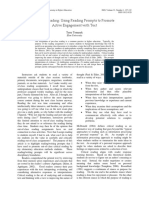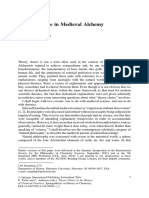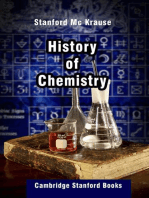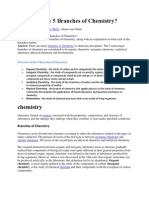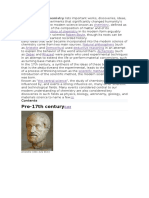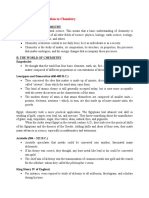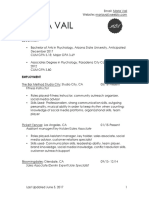Professional Documents
Culture Documents
1 An Overview of Physical and Phase Change
Uploaded by
Gede Krishna0 ratings0% found this document useful (0 votes)
91 views5 pagesa. Early traditions like alchemy, medicine, and technology laid foundations for chemistry but lacked scientific rigor, relying on mysticism or practical skills. They contributed laboratory methods still used today.
b. The phlogiston theory, which proposed an undetectable substance called phlogiston was released during burning, was disproven through Lavoisier's quantitative experiments showing that oxygen from air combines with combustible substances.
c. Lavoisier is considered the founder of modern chemistry for introducing quantitative experimentation and measurement to explain chemical reactions and properties rather than mystical concepts.
Original Description:
ki
Original Title
kimanor
Copyright
© © All Rights Reserved
Available Formats
DOCX, PDF, TXT or read online from Scribd
Share this document
Did you find this document useful?
Is this content inappropriate?
Report this Documenta. Early traditions like alchemy, medicine, and technology laid foundations for chemistry but lacked scientific rigor, relying on mysticism or practical skills. They contributed laboratory methods still used today.
b. The phlogiston theory, which proposed an undetectable substance called phlogiston was released during burning, was disproven through Lavoisier's quantitative experiments showing that oxygen from air combines with combustible substances.
c. Lavoisier is considered the founder of modern chemistry for introducing quantitative experimentation and measurement to explain chemical reactions and properties rather than mystical concepts.
Copyright:
© All Rights Reserved
Available Formats
Download as DOCX, PDF, TXT or read online from Scribd
0 ratings0% found this document useful (0 votes)
91 views5 pages1 An Overview of Physical and Phase Change
Uploaded by
Gede Krishnaa. Early traditions like alchemy, medicine, and technology laid foundations for chemistry but lacked scientific rigor, relying on mysticism or practical skills. They contributed laboratory methods still used today.
b. The phlogiston theory, which proposed an undetectable substance called phlogiston was released during burning, was disproven through Lavoisier's quantitative experiments showing that oxygen from air combines with combustible substances.
c. Lavoisier is considered the founder of modern chemistry for introducing quantitative experimentation and measurement to explain chemical reactions and properties rather than mystical concepts.
Copyright:
© All Rights Reserved
Available Formats
Download as DOCX, PDF, TXT or read online from Scribd
You are on page 1of 5
12.
1 AN OVERVIEW OF PHYSICAL AND
PHASE CHANGE
Each physical state is caleed a phase, a physically distinct, homogeneus part of
a system. The water in a closed container constitutes one phase; the water vapor
above the liquid is a second phase; add some ice, and there are three.
In this section, you’ll see that interactions between the potential energy and the
kinetic energy
12. 2 CHEMICAL ARTS AND THE ORIGIN OF
MODERN CHEMISTRY
This brief overview of early breakthroughs, and a few false directions, describes
how
the modern science of chemistry arose and progressed.
Prechemical Traditions
Chemistry had its origin in a prescientifi c past that incorporated three
overlapping
traditions—alchemy, medicine, and technology:
1. The alchemical tradition. Alchemy was an occult study of nature that began
in the 1st century ad and dominated thinking for over 1500 years. Originally infl
uenced
by the Greek idea that matter strives for “perfection,” alchemists later became
obsessed with converting “baser” metals, such as lead, into “purer” ones, such
as gold.
The alchemists’ names for substances and their belief that matter could be
altered
magically were very diffi cult to correct over the centuries. Their legacy to
chemistry
was in technical methods. They invented distillation, percolation, and extraction
and
devised apparatus still used routinely today (Figure 1.4). But perhaps even more
important was that alchemists encouraged observation and experimentation,
which
replaced the Greek approach of explaining nature solely through reason.
2. The medical tradition. Alchemists also infl uenced medical practice in
medieval
Europe. And ever since the 13th century, distillates and extracts of roots, herbs,
and
other plant matter have been used as sources of medicines. The alchemist and
physician
Paracelsus (1493–1541) considered the body to be a chemical system and
illness
an imbalance that could be restored by treatment with drugs. Although many
early
prescriptions were useless, later ones had increasing success. Thus began the
alliance
between medicine and chemistry that thrives today.
3. The technological tradition. For thousands of years, pottery making, dyeing,
and especially metallurgy contributed greatly to people’s experience with
materials.
During the Middle Ages and the Renaissance, books were published that
described
how to purify, assay, and coin silver and gold, how to use balances, furnaces,
and
crucibles, and how to make glass and gunpowder. Some introduced quantitative
measurement,
which was lacking in alchemical writings. Many creations from those times
are still marveled at throughout the world. Nevertheless, the skilled artisans
showed
little interest in why a substance changes or how to predict its behavior.
The Phlogiston Fiasco and the Impact of Lavoisier
Chemical investigation in the modern sense—inquiry into the causes of changes
in
matter—began in the late 17th century. At that time, most scientists explained
combustion,
the process of burning, with the phlogiston theory. It proposed that combustible
materials contain phlogiston, an undetectable substance released when the
material
burns. Highly combustible materials like charcoal were thought to contain a lot
of
phlogiston, and slightly combustible materials like metals only a little. But
inconsistencies
continuously arose.
Phlogiston critics: Why is air needed for combustion, and why does charcoal
stop burning in a closed vessel?
Phlogiston supporters: Air “attracts” phlogiston out of the charcoal, and burning
stops when the air in the vessel is “sat urated” with phlogiston.
Critics also noted that when a metal burns, it forms its calx, which weighs more
than
the metal, leading them to ask,
Critics: How can the loss of phlogiston cause a gain in mass?
Supporters: Phlogiston has negative mass.
As ridiculous as these responses seem now, it’s important to remember that,
even today,
scientists may dismiss conflicting evidence rather than abandon an accepted
idea.
The conflict over phlogiston was resolved when the young French chemist
Antoine Lavoisier (1743–1794) performed several experiments:
1. Heating mercury calx decomposed it into two products—mercury and a
gas—
whose total mass equaled the starting mass of the calx.
2. Heating mercury with the gas reformed the calx, and, again, the total mass
remained
constant.
3. Heating mercury in a measured volume of air yielded mercury calx and left
fourfifths
of the air remaining.
4. A burning candle placed in the remaining air was extinguished.
Lavoisier named the gas oxygen and gave metal calxes the name metal oxides.
His
explanation of his results made the phlogiston theory irrelevant:
• Oxygen, a normal component of air, combines with a substance when it burns.
• In a closed container, a combustible substance stops burning when it has
combined
with all the available oxygen.
• A metal calx (metal oxide) weighs more than the metal because its mass
includes
the mass of the oxygen.
This new theory triumphed because it relied on quantitative, reproducible
measurements,
not on strange properties of undetectable substances. Because this approach is at
the heart of science, many propose that the science of chemistry began with
Lavoisier.
Summary
a. Alchemy, medicine, and technology placed little emphasis on objective
experimentation, focusing instead on mystical explanations or practical
experience,
but these traditions contributed some apparatus and methods that are still
important.
b. Lavoisier overthrew the phlogiston theory by showing quantitatively that
oxygen,
a component of air, is required for combustion and combines with a burning
substance.
g
You might also like
- AlchemyDocument22 pagesAlchemydoinita70% (1)
- Critical Reading, Using Reading Prompts To Promote Active Engagement With Text Final PDFDocument6 pagesCritical Reading, Using Reading Prompts To Promote Active Engagement With Text Final PDFemysamehNo ratings yet
- ProductiveDocument3 pagesProductiveKharisma Rosa100% (1)
- Physical Science B: Jan Mark E. Perales, LPT, SST-IDocument64 pagesPhysical Science B: Jan Mark E. Perales, LPT, SST-IAngela Otaza TuraNo ratings yet
- J910-DH02-P0ZEN-049002 - B - ITP For Fence and GateDocument12 pagesJ910-DH02-P0ZEN-049002 - B - ITP For Fence and GateAdrianus Hindradjaja100% (2)
- A Guide For ChemistsDocument188 pagesA Guide For Chemistsneculaitarabuta100% (2)
- General and Inorganic ChemistryhandoutDocument25 pagesGeneral and Inorganic ChemistryhandoutleapapayNo ratings yet
- Module 1 - The Nature of ChemistryDocument12 pagesModule 1 - The Nature of ChemistryElhamae Sindatoc100% (1)
- Interview Questions For FreshersDocument3 pagesInterview Questions For FreshersEprusunnah0% (1)
- RRL - Perceived Effects of Laissez-Faire in Research Group SatisfactionDocument39 pagesRRL - Perceived Effects of Laissez-Faire in Research Group SatisfactionMark Darrel PerezNo ratings yet
- Medieval AlchemyDocument11 pagesMedieval AlchemydrecksenNo ratings yet
- History of ChemistryDocument10 pagesHistory of ChemistryThamil AnbanNo ratings yet
- Branches of ChemistryDocument9 pagesBranches of ChemistryYhan Brotamonte Boneo100% (1)
- Chemistry Before Modern HistoryDocument26 pagesChemistry Before Modern Historypepito protacioNo ratings yet
- F4.2 Mabalacat ZO 2018Document67 pagesF4.2 Mabalacat ZO 2018Jeysii PaduaNo ratings yet
- SVMDocument12 pagesSVMNarmatha BalachandarNo ratings yet
- Kotler On Strategic MarketingDocument15 pagesKotler On Strategic MarketingYenyensmile100% (1)
- Chapter 1 General View of Chemistry and MatterDocument17 pagesChapter 1 General View of Chemistry and MatterJoshua Kulot100% (1)
- Yeah! Science Qwikipedia ChemistryDocument22 pagesYeah! Science Qwikipedia ChemistryAmy Cecilia LeighNo ratings yet
- History of ChemistryDocument9 pagesHistory of ChemistryLyrielle DagsaNo ratings yet
- Introduction To ChemistryDocument33 pagesIntroduction To ChemistryJeNo ratings yet
- Chemistry 5Document3 pagesChemistry 5EINSTEINNo ratings yet
- Chapter 1 General View of Chemistry and Matter (Autorecovered)Document29 pagesChapter 1 General View of Chemistry and Matter (Autorecovered)explorers.beamaepetracortaNo ratings yet
- Lesson 1 Introduction To ChemistryDocument5 pagesLesson 1 Introduction To ChemistryEnrico Sapitula Del RosarioNo ratings yet
- Fulltext 001Document12 pagesFulltext 001Agus SurahmanNo ratings yet
- Experiment No 9 Lab ReportDocument16 pagesExperiment No 9 Lab ReportRos Vincent AlvarezNo ratings yet
- Adge CompiledDocument18 pagesAdge CompiledNovelyn LumboyNo ratings yet
- History: Chemistry Is TheDocument4 pagesHistory: Chemistry Is TheKim Caitlin Carbolico ClasieteNo ratings yet
- Tcvge Wtyorerd2222Document18 pagesTcvge Wtyorerd2222kingNo ratings yet
- Evolution of Modern Chemistry. in The Hands of The "Oxford Chemists" (Robert Boyle, RobertDocument2 pagesEvolution of Modern Chemistry. in The Hands of The "Oxford Chemists" (Robert Boyle, RobertЮля ПавлущикNo ratings yet
- History of ChemistryDocument5 pagesHistory of ChemistryJohn Kenneth Escober BentirNo ratings yet
- Atoms, What?: WavesDocument4 pagesAtoms, What?: Wavesjose_dino10005190No ratings yet
- Chapter 1 (Lesson 1-History of Chemistry)Document8 pagesChapter 1 (Lesson 1-History of Chemistry)Jean Rose GenovaNo ratings yet
- Chemistry Before LavoisierDocument4 pagesChemistry Before LavoisierDewan Olin ChotepadaeNo ratings yet
- Phlogiston Theory: From Wikipedia, The Free EncyclopediaDocument26 pagesPhlogiston Theory: From Wikipedia, The Free EncyclopediaAnonymous W6zPy3fImvNo ratings yet
- From Wikipedia, The Free EncyclopediaDocument27 pagesFrom Wikipedia, The Free EncyclopediaJhunelynNo ratings yet
- PHILOSOPHERDocument7 pagesPHILOSOPHERJerick AndersonNo ratings yet
- Knight 2004 Chemical Sciences History and SociologyDocument5 pagesKnight 2004 Chemical Sciences History and Sociologyashakow8849No ratings yet
- Pre-17th Century: Chemistry History of Chemistry Robert BoyleDocument10 pagesPre-17th Century: Chemistry History of Chemistry Robert BoyleRodrigo GarciaNo ratings yet
- The History of ChemistryDocument1 pageThe History of ChemistryRalu Raluca100% (1)
- A Quick History of ChemistryDocument48 pagesA Quick History of ChemistryFaisal BachaNo ratings yet
- Historia Do OxigênioDocument9 pagesHistoria Do Oxigêniommariaeduarda18No ratings yet
- Hammurab I: Time Intervals Specifi C Times Events DescriptionDocument8 pagesHammurab I: Time Intervals Specifi C Times Events DescriptionVianne Fides IliganNo ratings yet
- History of Organic ChemistryDocument16 pagesHistory of Organic ChemistrypugandjNo ratings yet
- Chapter 1 IntroDocument5 pagesChapter 1 IntroChane ReponteNo ratings yet
- ModernchemistryDocument7 pagesModernchemistryprinceuduma2021No ratings yet
- Sardar Bahadur Khan Women University (SBK)Document11 pagesSardar Bahadur Khan Women University (SBK)Zeenat MoambarNo ratings yet
- Evolution of Modern ChemistryDocument2 pagesEvolution of Modern ChemistryNanette MangloNo ratings yet
- Chapter 1 - SeatworkDocument3 pagesChapter 1 - SeatworkVincent DayangcoNo ratings yet
- Part 4 The History of ChemistryDocument27 pagesPart 4 The History of ChemistryAsep Saefuddin Ash ShidiqNo ratings yet
- History of Chemistry 1Document2 pagesHistory of Chemistry 1Юля ПавлущикNo ratings yet
- English For Chemistry - Unit 1Document6 pagesEnglish For Chemistry - Unit 1AHMAD FAHRUDIN100% (1)
- Chemical Evolution-Theory and Hypothesis TestingDocument5 pagesChemical Evolution-Theory and Hypothesis TestingUmmi Nur DinniNo ratings yet
- Module 1: An Introduction To Chemistry: A. Definition of ChemistryDocument24 pagesModule 1: An Introduction To Chemistry: A. Definition of ChemistryJecris RamosNo ratings yet
- Birth of ChemistryDocument37 pagesBirth of ChemistryMusa şenNo ratings yet
- A History of Science (Volume 4)Document311 pagesA History of Science (Volume 4)simona robuNo ratings yet
- Chemistry 2Document9 pagesChemistry 2Eller-jed M. MendozaNo ratings yet
- Chapter 1Document5 pagesChapter 1Mark Euan B. DolosoNo ratings yet
- Inorganic ChemistryDocument2 pagesInorganic ChemistryNicole LaquilacNo ratings yet
- Natural Sciences: GEN 106 Spring 2016 Assignment #1Document6 pagesNatural Sciences: GEN 106 Spring 2016 Assignment #1Aboubakr SoultanNo ratings yet
- Chemistry: ScienceDocument11 pagesChemistry: ScienceChe MatNo ratings yet
- Lesson 1 - Development of Atomic StructureDocument8 pagesLesson 1 - Development of Atomic StructureThañeza Mae PeraNo ratings yet
- History PHYSICS: Renaissance, and Early Modern ScienceDocument3 pagesHistory PHYSICS: Renaissance, and Early Modern Scienceparvezbub_490779093No ratings yet
- JBKHJDocument7 pagesJBKHJImmortal DynastyNo ratings yet
- Unit I: Introduction To Chemistry: LEARNING OUTCOMES: After Successful Completion of This Unit, You Should Be Able ToDocument23 pagesUnit I: Introduction To Chemistry: LEARNING OUTCOMES: After Successful Completion of This Unit, You Should Be Able ToMabale, Joyce Danielle H.No ratings yet
- Humana Science NiDocument62 pagesHumana Science NiRascel SumalinogNo ratings yet
- PFD Control - Case (Main)Document1 pagePFD Control - Case (Main)Gede KrishnaNo ratings yet
- This Is The Method of Marketing Plan in 2019: Go and Buy Stuff Just Do ItDocument1 pageThis Is The Method of Marketing Plan in 2019: Go and Buy Stuff Just Do ItGede KrishnaNo ratings yet
- Presentasi IBR Kelompok 1Document24 pagesPresentasi IBR Kelompok 1Gede KrishnaNo ratings yet
- Presentasi IBR Kelompok 1Document11 pagesPresentasi IBR Kelompok 1Gede KrishnaNo ratings yet
- Structure of MetalDocument19 pagesStructure of MetalGede KrishnaNo ratings yet
- Calculating Magnification Worksheet AnswersDocument1 pageCalculating Magnification Worksheet AnswersMary Ann Maher100% (1)
- R2RLOGDocument12 pagesR2RLOGYaya YaraNo ratings yet
- G 5Document17 pagesG 5Ian Marco SazonNo ratings yet
- LogcatDocument3,139 pagesLogcatvatsavai swathiNo ratings yet
- Work Breakdown Structures: White PaperDocument6 pagesWork Breakdown Structures: White PaperjmpbarrosNo ratings yet
- Title Page PrelimenariesDocument14 pagesTitle Page PrelimenariesDosirt VisdaNo ratings yet
- Exp4-Add, Sub, Mul, Div of 8 Bit & 16 BitDocument6 pagesExp4-Add, Sub, Mul, Div of 8 Bit & 16 Bitjinto0007No ratings yet
- Approved IRR MAR122014Document49 pagesApproved IRR MAR122014kingsol_archiNo ratings yet
- Maria Vail ResumeDocument2 pagesMaria Vail Resumeapi-360258460No ratings yet
- Rancière: DissensusDocument3 pagesRancière: DissensusRicardo RoqueNo ratings yet
- Declamation - APJ Abdul Kalam Speech by AgastyaDocument1 pageDeclamation - APJ Abdul Kalam Speech by AgastyaPoop MasterNo ratings yet
- Moa JciDocument5 pagesMoa JcirnrmmanphdNo ratings yet
- Full Download Test Bank For Canadian Organizational Behaviour 8th Edition Mcshane PDF Full ChapterDocument36 pagesFull Download Test Bank For Canadian Organizational Behaviour 8th Edition Mcshane PDF Full Chapterpeelefisc7vnzww100% (17)
- Tele CommunicationDocument0 pagesTele Communicationwww.bhawesh.com.npNo ratings yet
- Robopro Software For: FischerDocument27 pagesRobopro Software For: FischerEvan AV100% (1)
- Catalogextract pdf+16-17Document871 pagesCatalogextract pdf+16-17Mahmoud HosnyNo ratings yet
- Bottle Jack: TON ToneladasDocument4 pagesBottle Jack: TON ToneladasMarĭo Isaac Manrĭquéz LealNo ratings yet
- Reaction Paper NegotiationDocument1 pageReaction Paper NegotiationDanielle Elesterio100% (1)
- UNYOUG Exadata NiemiecDocument178 pagesUNYOUG Exadata NiemiecasifanwNo ratings yet
- Activarlo en CMDDocument1 pageActivarlo en CMDGuillermina Delgado92% (12)
- Cagayan de Oro College.2Document10 pagesCagayan de Oro College.2Jenevie DecenillaNo ratings yet
- Activity Worksheet FieldtripDocument5 pagesActivity Worksheet Fieldtripbutchabdon1992No ratings yet

